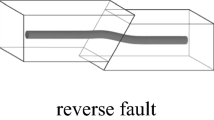Abstract
Line structures such as pipelines that cross active faults should be designed to retain leaktightness if the design displacement (Ddesign) occurs. Principal approaches to the Ddesign and rupture kinematics assessment are described. They are based on relationships between earthquake magnitude, rupture length and displacement, and on the detailed field data on a specific fault that crosses the pipeline route. Since the future offset at the crossing may exceed the design value, the probability of a displacement occurrence where the safety of the structure can not be ensured should be estimated. Assessment method on such event probability is described and exemplified through active fault studies carried out at several pipeline projects in Russia.
Similar content being viewed by others
Reference
Barka A (1992) The North Anatolian fault zone. Annales Tectonicae, Special Issue, Supplement to 6:164–195.
Biasi GP, Weldon II RJ (2006) Estimating surface rupture length and magnitude of paleoearthquakes from point measurements of rupture displacement. Bulletin Seismological Society of America 96:1612–1623.
Bulgakov PF, Ivaschenko AI, Kim Chun UN, et al. (2002) Active faults of Sakhalin. Geotectonics 36:227–246.
Chipizubbov AV (1998) Identification of single-event and evenaged past surface ruptures and assessment of past earthquakes magnitudes on the base of their dimensions. Russian Geology and Geophysics 39(3):386–398.
Dowrick DJ, Rhoades DA (2004) Relations between earthquake magnitude and fault rupture dimensions: how regionally variable are they? Bulletin Seismological Society of America 94:776–788.
Haeussler PJ, Schwartz DP, Dawson TE, et al. (2004) Surface rupture and slip distribution of the Denali and Totschunda Faults in the 3 November 2002 M 7.9 Earthquake, Alaska. Bulletin Seismological Society of America 94(6B):23–52
Ghose S, Mellors RJ, Korjenkov AM, et al. (1997). The Ms=7.3 1992 Suusamyr, Kyrgyzstan, Earththquake in the Tien Shan: 2. Aftershock focal mechanisms and surface deformation. Bulletin Seismological Society of America 87:23–38.
Lunina OV (2001) Effect of the lithosphere stress on the relationships of surface rupture parameters and earthquake magnitudes. Russian Geology and Geophysics 42:1389–1398.
Matsuda T (1998) Present state of long-term prediction of earthquakes based on active fault data in Japan. Zisin, Journal Seismological Society of Japan, 2nd series 50:23–33.
Mattiozzi P, Strom AL (2008) Crossing Active Faults on the Sakhalin II Onshore Pipeline Route: Pipeline Design and Risk Analysis. In A. Santini and N. Moraci (eds.), 2008 Seismic Engineering Conference Commemorating the 1908 Messina and Reggio Calabria Earthquake. American Institute of Physics, pp 1004–1013.
McCalpin JP (Ed.) (1996) Paleoseismology. San Diego: Academic Press. pp 1–588.
McCalpin JP (Ed.) (2009) Paleoseismology. 2nd edition. Academic Press, imprint of Elsevier pp 1–613.
Nowroozi AA (1985) Empirical relations between magnitudes and fault parameters for earthquakes in Iran, Bulletin Seismological Society of America 75:1327–1338.
Nowroozi AA, Mohajer-Ashjai A (1985) Fault movements and tectonics of Eastern Iran: Boundaries of the Lut Plate. Geophysical Journal Royal Astronomical Society 83:215–237.
Otsuka M (1964) Earthquake magnitude and surface fault formation. J. Phys. Earth, 12:19–24.
Ryall AS, VanWormer JD (1980) Estimations of maximum magnitude and recommended seismic zone changes in the Western Great Basin. Bulletin Seismological Society of America 70:1573–1581.
Strom AL (2000) Assessment of seismic rupture displacement values and of their occurrence probability. In Assessment and monitoring of natural risks, Proccedings of the “Risk-2000” Conference. Moscow, 37–41. (In Russian).
Strom AL, Nikonov AA (1997) Relationships between seismic faults parameters and earthquakes’ magnitude. Izvestia, Physics of the Earth 33(12):1011–1022.
Strom AL, Nikonov AA (2000) Slip distribution along seismic faults and consideration of their irregularity for paleoseismological studies. Volcanology and Seismology 21:705–722.
Todorovska MI, Trifunac MD (2006) A note on probabilistic assessment of fault displacement hazard. In Proceedings of the 8th U.S. National Conference on Earthquake Engineering. April 18–22, 2006, San Francisco, California, USA. Paper No. 1793.
Wells DL, Coppersmith KJ (1994) New empirical relationships among magnitude, rupture length, rupture width, rupture area, and surface displacement. Bulletin Seismological Society of America 84:974–1002.
Youngs RR, Arabasz WJ, Anderson RE, et al. (2003) A methodology for probabilistic fault displacement hazard analysis (PFDHA), Earthquake Spectra 19(1):191–219.
Author information
Authors and Affiliations
Corresponding author
Rights and permissions
About this article
Cite this article
Strom, A., Ivaschenko, A. & Kozhurin, A. Assessment of the design displacement values at seismic fault crossings and of their excess probability. J. Mt. Sci. 8, 228–233 (2011). https://doi.org/10.1007/s11629-011-2085-8
Received:
Accepted:
Published:
Issue Date:
DOI: https://doi.org/10.1007/s11629-011-2085-8




